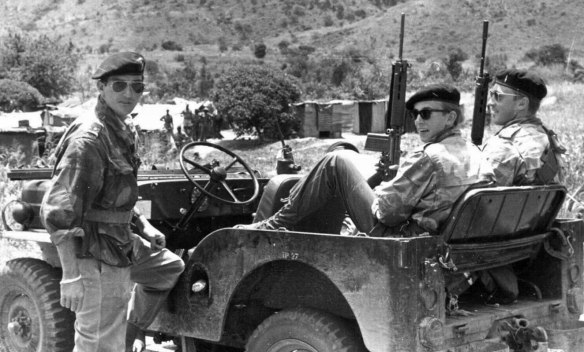“Commando Kivu,” a unit fighting Simba rebels in the area along the west side of Lake Kivu, just across from Rwanda.
Another photo (right) appears to show Robert Denard himself (center) in 1965.
Colonel Denard. In his autobiography Corsaire de la République (“Pirate of the Republic”), Denard gave his assessment of the situation in the Congo: “Naively, I had hoped that after the end of Katanga, the UN forces that had a mandate to remain in Congo until 30 June 1964 would easily impose peace. It did not happen. I found that the country was a pressurized boiler about to explode. A new rebellion was bloody: the Simbas were followers of Pierre Mulele, founder of a sect called the Anti-Immaculate Conception. This anti-religious fanatic baptized his warriors with water magic to make them invulnerable to bullets
The Congo paid heavily for the chaos surrounding the advent of independence. For years to come it became a battleground for warring factions, marauding soldiers, foreign troops, mercenary forces, revolutionary enthusiasts and legions of diplomats and advisers. Katanga struggled to maintain its secession for another two years, until in 1963 the United Nations put an end to it.
Then, in 1964, revolt and rebellion broke out in the eastern Congo, Lumumba’s former stronghold, on a scale that surpassed anything the Congo had experienced before. In the space of three months the Leopoldville government lost control of half of the entire country. In Stanleyville former Lumumba supporters set up a ‘ People’s Republic of the Congo ‘ and ordered the mass executions of clerks, teachers, civil servants, merchants – men deemed to be ‘ counter-revolutionaries ‘ or ‘ intellectuals ‘ ; at least 20,000 Congolese died, many of them executed with appalling cruelty in public at the foot of monuments to Lumumba. Support for the Stanleyville regime came from China, Cuba, Algeria and Egypt.
To prevent the Congo from disintegrating, the United States and Belgium undertook a massive rescue operation, supplying combat aircraft, transport planes, counter-insurgency experts and hundreds of technicians. Under the auspices of the CIA, Cuban refugee pilots and European mechanics were hired to staff a combat air force. A mercenary force was assembled – a rough assortment of adventurers, desperadoes and misfits , together with some professional soldiers, recruited mainly in Rhodesia and South Africa.
Facing defeat, the Stanleyville regime seized some three hundred Belgian and American hostages. Belgian paratroops, transported by American planes, were dropped on Stanleyville to rescue them. In all, some 2,000 whites were evacuated from the eastern Congo. Three hundred others, some of them missionaries living in remote outposts, were murdered. As mercenary groups and government troops beat back rebel opposition, they left behind a terrible trail of repression and plunder. Overall, a million people were estimated to have died in the 1964 rebellions.
In Leopoldville the politicians resumed their bickering and intrigue once more until in 1965 Mobutu, the army commander, stepped forward for a second time, suspended all political activity and assumed the presidency for himself. At the time, it seemed to offer some prospect of respite.
In 1971, the Congo was renamed Zaire, in an attempt by Mobutu, now the ruler, to strengthen the nation’s African identity after the postcolonial turmoil of the 1960s. Mobutu also changed his own name to Mobutu Sese Seko Kuku Ngbendu wa za Banga (“Mobutu, the allpowerful warrior who, because of his endurance and inflexible will to win, will go from conquest to conquest leaving fire in his wake”). However, Mobutu was overthrown in 1997, and the country’s name was restored to the Democratic Republic of the Congo.
